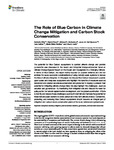The Role of Blue Carbon in Climate Change Mitigation and Carbon Stock Conservation
| dc.contributor.author | Hilmi, N | |
| dc.contributor.author | Chami, R | |
| dc.contributor.author | Sutherland, MD | |
| dc.contributor.author | Hall-Spencer, Jason | |
| dc.contributor.author | Lebleu, L | |
| dc.contributor.author | Benitez, MB | |
| dc.contributor.author | Levin, LA | |
| dc.date.accessioned | 2021-09-20T15:17:08Z | |
| dc.date.available | 2021-09-20T15:17:08Z | |
| dc.date.issued | 2021-09-07 | |
| dc.identifier.issn | 2624-9553 | |
| dc.identifier.issn | 2624-9553 | |
| dc.identifier.uri | http://hdl.handle.net/10026.1/17882 | |
| dc.description.abstract |
<jats:p>The potential for Blue Carbon ecosystems to combat climate change and provide co-benefits was discussed in the recent and influential Intergovernmental Panel on Climate Change Special Report on the Ocean and Cryosphere in a Changing Climate. In terms of Blue Carbon, the report mainly focused on coastal wetlands and did not address the socio-economic considerations of using natural ocean systems to reduce the risks of climate disruption. In this paper, we discuss Blue Carbon resources in coastal, open-ocean and deep-sea ecosystems and highlight the benefits of measures such as restoration and creation as well as conservation and protection in helping to unleash their potential for mitigating climate change risks. We also highlight the challenges—such as valuation and governance—to marshaling their mitigation role and discuss the need for policy action for natural capital market development, and for global coordination. Efforts to identify and resolve these challenges could both maintain and harness the potential for these natural ocean systems to store carbon and help fight climate change. Conserving, protecting, and restoring Blue Carbon ecosystems should become an integral part of mitigation and carbon stock conservation plans at the local, national and global levels.</jats:p> | |
| dc.format.extent | 710546- | |
| dc.language.iso | en | |
| dc.publisher | Frontiers Media SA | |
| dc.subject | 13 Climate Action | |
| dc.title | The Role of Blue Carbon in Climate Change Mitigation and Carbon Stock Conservation | |
| dc.type | journal-article | |
| dc.type | Review | |
| dc.type | Journal | |
| plymouth.volume | 3 | |
| plymouth.publication-status | Published online | |
| plymouth.journal | Frontiers in Climate | |
| dc.identifier.doi | 10.3389/fclim.2021.710546 | |
| plymouth.organisational-group | /Plymouth | |
| plymouth.organisational-group | /Plymouth/Faculty of Science and Engineering | |
| plymouth.organisational-group | /Plymouth/Faculty of Science and Engineering/School of Biological and Marine Sciences | |
| plymouth.organisational-group | /Plymouth/PRIMaRE Publications | |
| plymouth.organisational-group | /Plymouth/REF 2021 Researchers by UoA | |
| plymouth.organisational-group | /Plymouth/REF 2021 Researchers by UoA/UoA07 Earth Systems and Environmental Sciences | |
| plymouth.organisational-group | /Plymouth/Research Groups | |
| plymouth.organisational-group | /Plymouth/Research Groups/Marine Institute | |
| plymouth.organisational-group | /Plymouth/Users by role | |
| plymouth.organisational-group | /Plymouth/Users by role/Academics | |
| dcterms.dateAccepted | 2021-08-11 | |
| dc.rights.embargodate | 2021-9-22 | |
| dc.identifier.eissn | 2624-9553 | |
| dc.rights.embargoperiod | Not known | |
| rioxxterms.versionofrecord | 10.3389/fclim.2021.710546 | |
| rioxxterms.licenseref.uri | http://www.rioxx.net/licenses/all-rights-reserved | |
| rioxxterms.licenseref.startdate | 2021-09-07 | |
| rioxxterms.type | Journal Article/Review |


